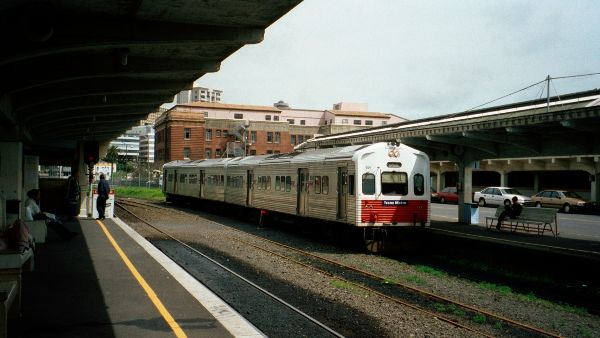End Of The Line For Papakura To Pukekohe’s Diesel Train Shuttle
It’s time to say Haere rā to the diesel trains that revived rail in Auckland, as work revs up to modernise the city’s rail network.

This Friday marks the end of the line for Papakura to Pukekohe’s diesel passenger train service.
This southernmost Papakura to Pukekohe rail connection will now be suspended, to allow the 19km section of line to be electrified.
As the upgrade is happening, the service will be replaced with buses. Electric trains, which are currently used on the remainder of Auckland’s Metro network, are expected to start travelling to Pukekohe by the second half of 2024.
A replacement bus (394) will be free for customers with an AT HOP card and will run on the same frequency as the train.
Reviving rail in the ‘90s
The trains known as Diesel Multiple Units (DMUs) played an integral role in revitalising Auckland’s rail commute network in the 1990s and early 2000s.
Auckland Transport’s Raymond Siddalls says it’s a bittersweet moment – as the diesel trains saved Auckland’s commuter rail service from likely closure.
Mr Siddalls played a crucial role in getting redundant passenger trains from Perth to Auckland in the early ‘90s.
“The value back then was AUD $56m and we eventually purchased 19 two-car trains. I justified a budget of NZ $10m for the project, this included shipping and interior refurbishment; I also negotiated a 10-year extension to operation contract with the Regional Council to justify this investment,” Mr Siddalls says.
“When the DMUs came to Auckland they were fully operational. When we started negotiations to buy them, five of the two-car trains were only five years old, and another five were ten years old. That made them newer than any other passenger trains in New Zealand at that time (1990).
“These DMUs helped justify the electrification of the Perth rail network. When they arrived in Auckland, after an interior refurbishment, they attracted daily use by commuters, school students and university students. The DMUs were too successful and didn’t have capacity to carry all the potential customers. They were the catalyst for justifying further investment in the Auckland Metro rail network and the eventual introduction of the electric services.”
Gearing up for a new era of rail
KiwiRail’s Chief Operating Officer - Capital Projects David Gordon says Aucklanders are starting to see a ramp up in work to improve the city’s rail network.
“The City Rail Link (CRL) is going to be a game-changer for Auckland - allowing more frequent and more convenient commuter services to get people around the city, which will help reduce carbon emissions. But to get to that point there is a lot to be done over the next few years.”
Funded through the Government’s NZ Upgrade Programme, KiwiRail is extending the electrified network from Papakura to Pukekohe. The project includes installing the electrification masts and wires, redeveloping Pukekohe station, and building platforms for three new stations. KiwiRail will also be upgrading the formation (the layer of rocks under the tracks) on this section of line, ready for CRL operations.
“Most of this work will require at least one track, and often two, to be closed at multiple locations along the route. Without suspending the DMU commuter service, we would not be able to get the work done safely and ensure it is completed before CRL begins operating,” David Gordon says.
“The electrification work is one of a number of rail improvement projects KiwiRail is undertaking across Auckland – from building three new stations between Papakura and Pukekohe, a new rail track on the busiest section of the city’s railway between Westfield and Wiri junctions, and infrastructure upgrades across the metro network.”
Buses will replace rail for Papakura to Pukekohe service
Auckland Transport’s Interim Chief Executive, Mark Lambert, says bus replacements are a necessary step to ultimately deliver a better commuter service in southern Auckland.
“The alternative would see rail passengers travelling between Papakura and Pukekohe facing many years of disrupted journeys, and a delayed completion date.
“The electrification work is expected to be completed, with Metro services expected to start running to Pukekohe, by the second half of 2024. Then in 2025 the three new stations between Papakura and Pukekohe should be open to the public.
“Commuters in the south will experience cleaner, faster journeys and they will no longer need to change trains at Papakura.”
For more information: AT.govt.nz/PukekoheTrains


 Gordon Campbell: On The Trump Upside, And Peters Persecution Of Trans People
Gordon Campbell: On The Trump Upside, And Peters Persecution Of Trans People New Zealand Government: Accelerating The Roll-Out Of Public EV Chargers
New Zealand Government: Accelerating The Roll-Out Of Public EV Chargers Save the City-to-Sea Bridge: Join on Sunday afternoon to save Wellington’s City-to-Sea Bridge
Save the City-to-Sea Bridge: Join on Sunday afternoon to save Wellington’s City-to-Sea Bridge New Zealand Defence Force: Second World War Veterans Receive Message From King Charles
New Zealand Defence Force: Second World War Veterans Receive Message From King Charles New Zealand Government: More Than 900 Health Graduates To Receive Financial Boost Through Bonding Scheme
New Zealand Government: More Than 900 Health Graduates To Receive Financial Boost Through Bonding Scheme New Zealand Police: Stacks Of Cocaine Unpacked In Mt Wellington
New Zealand Police: Stacks Of Cocaine Unpacked In Mt Wellington Te Pāti Māori: Te Pāti Māori Make Submission To Privileges Committee In Absentia
Te Pāti Māori: Te Pāti Māori Make Submission To Privileges Committee In Absentia


